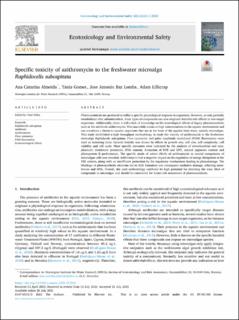| dc.contributor.author | Almeida, Ana Catarina | |
| dc.contributor.author | Gomes, Tânia | |
| dc.contributor.author | Baz-Lomba, Jose Antonio | |
| dc.contributor.author | Lillicrap, Adam David | |
| dc.date.accessioned | 2021-12-10T12:16:32Z | |
| dc.date.available | 2021-12-10T12:16:32Z | |
| dc.date.created | 2021-11-12T08:44:03Z | |
| dc.date.issued | 2021 | |
| dc.identifier.citation | Ecotoxicology and Environmental Safety. 2021, 222, 112553. | en_US |
| dc.identifier.issn | 0147-6513 | |
| dc.identifier.uri | https://hdl.handle.net/11250/2833785 | |
| dc.description.abstract | Pharmaceuticals are produced to inflict a specific physiological response in organisms. However, as only partially metabolized after administration, these types of compounds can also originate harmful side effects to non-target organisms. Additionally, there is still a lack of knowledge on the toxicological effects of legacy pharmaceuticals such as the antibiotic azithromycin. This macrolide occurs at high concentrations in the aquatic environment and can constitute a threat to aquatic organisms that are at the basis of the aquatic food chain, namely microalgae. This study established a high‐throughput methodology to study the toxicity of azithromycin to the freshwater microalga Raphidocelis subcapitata. Flow cytometry and pulse amplitude modulated (PAM) fluorometry were used as screening tools. General toxicity was shown by effects in growth rate, cell size, cell complexity, cell viability and cell cycle. More specific outcomes were indicated by the analysis of mitochondrial and cytoplasmatic membrane potentials, DNA content, formation of ROS and LPO, natural pigments content and photosystem II performance. The specific mode of action (MoA) of azithromycin to crucial components of microalgae cells was revealed. Azithromycin had a negative impact on the regulation of energy dissipation at the PSII centers, along with an insufficient protection by the regulatory mechanisms leading to photodamage. The blockage of photosynthetic electrons led to ROS formation and consequent oxidative damage, affecting membranes and DNA. Overall, the used methodology exhibited its high potential for detecting the toxic MoA of compounds in microalgae and should be considered for future risk assessment of pharmaceuticals. | en_US |
| dc.language.iso | eng | en_US |
| dc.publisher | Elsevier | en_US |
| dc.rights | Attribution-NonCommercial-NoDerivatives 4.0 Internasjonal | * |
| dc.rights.uri | http://creativecommons.org/licenses/by-nc-nd/4.0/deed.no | * |
| dc.title | Specific toxicity of azithromycin to the freshwater microalga Raphidocelis subcapitata | en_US |
| dc.type | Peer reviewed | en_US |
| dc.type | Journal article | en_US |
| dc.description.version | publishedVersion | en_US |
| dc.rights.holder | © 2021 The Authors. | en_US |
| dc.source.pagenumber | 12 | en_US |
| dc.source.volume | 222 | en_US |
| dc.source.journal | Ecotoxicology and Environmental Safety | en_US |
| dc.identifier.doi | 10.1016/j.ecoenv.2021.112553 | |
| dc.identifier.cristin | 1953895 | |
| dc.relation.project | Norges forskningsråd: 160016 | en_US |
| dc.source.articlenumber | 112553 | en_US |
| cristin.ispublished | true | |
| cristin.fulltext | original | |
| cristin.qualitycode | 2 | |

